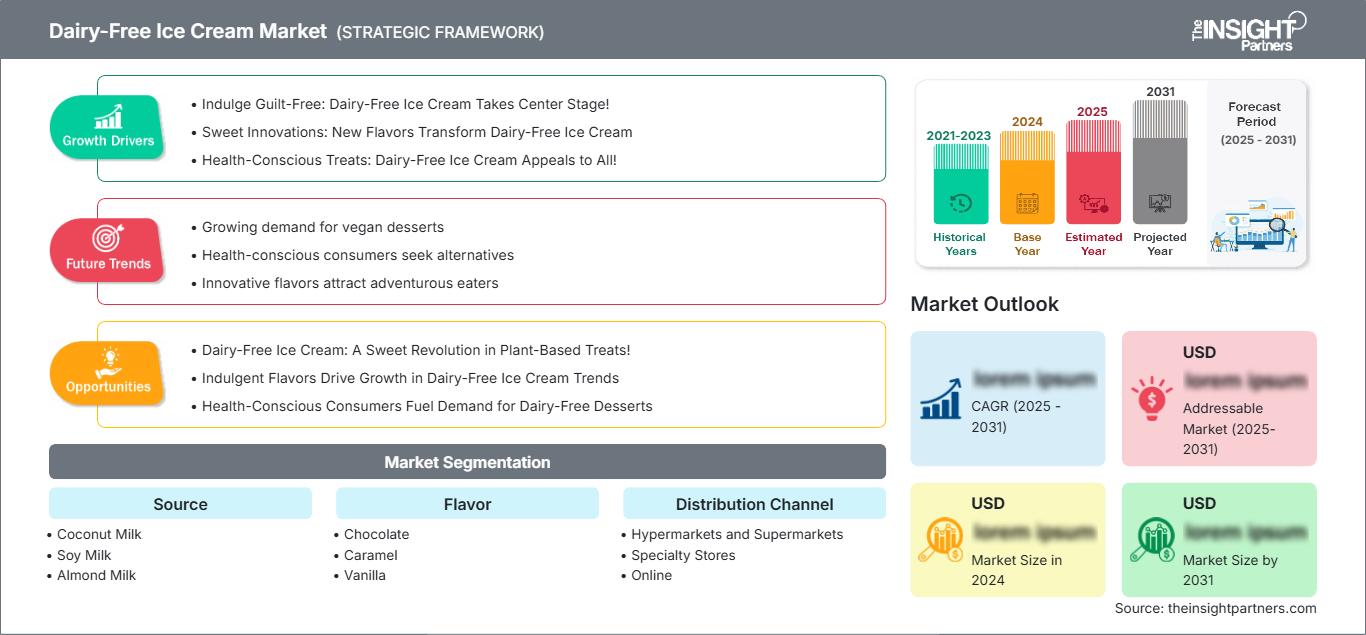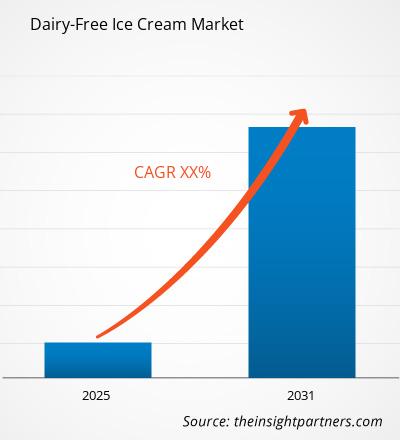The marché des glaces sans produits laitiers devrait enregistrer une croissance régulière de 2026 à 2034, sa valorisation étant projetée pour croître à partir de la référence de 2025 et progresser jusqu’à la fin de la période de prévision. Cette tendance reflète une perspective favorable du marché, portée par l’évolution des exigences du secteur et les avancées technologiques en cours.
The rapport est classé par source (lait de coco, lait de soja, lait d’amande, lait de noix de cajou) et analyse plus en détail le marché selon la saveur (chocolat, caramel, vanille, fruit). Il examine également le marché par canal de distribution (hypermarchés et supermarchés, magasins spécialisés, en ligne). Une répartition complète est fournie aux niveaux mondial, régional et national pour chacun de ces segments clés.
Le rapport inclut la taille du marché et les prévisions pour tous les segments, présentant les valeurs en USD. Il fournit également des statistiques clés sur l’état actuel du marché des principaux acteurs, ainsi que des informations sur les tendances dominantes et les opportunités émergentes.
Purpose du rapport Report
The Marché des glaces sans produits laitiers par The Insight Partners vise à décrire le paysage actuel et la croissance future, les principaux facteurs moteurs, les défis et les opportunités. Cela fournira des informations à divers acteurs métier, tels que :
- Technology Fournisseurs/Fabricants : Comprendre l’évolution des dynamiques du marché et connaître les opportunités de croissance potentielles, leur permettant de prendre des décisions stratégiques éclairées.
- Investors : Réaliser une analyse complète des tendances concernant le taux de croissance du marché, les projections financières du marché et les opportunités existantes sur toute la chaîne de valeur.
- Organismes de régulation : Réguler les politiques et surveiller les activités sur le marché dans le but de minimiser les abus, préserver la confiance et la confiance des investisseurs, et préserver l’intégrité et la stabilité du marché. Segmentation du marché de la glace sans
Dairy Source
- Coconut Milk
- Soja Milk
- Amande Milk
- Cajou Milk
Flavor
- Chocolate
- Caramel
- Vanilla
- Fruit
Distribution Canal
- Hypermarkets et Supermarkets
- Stores
- Online
spécialisé
Vous bénéficierez d’une personnalisation sur n’importe quel rapport - gratuitement - y compris des parties de ce rapport, ou une analyse au niveau du pays, un pack de données Excel, ainsi que de profiter d’offres exceptionnelles et de réductions pour les start-ups et les universités
Marché de glaces sans produits laitiers: Perspectives stratégiques

-
Obtenez les principales tendances clés du marché de ce rapport.Cet échantillon GRATUIT comprendra une analyse de données, allant des tendances du marché aux estimations et prévisions.
Facteurs de croissance du marché des crèmes glacées sans produits laitiers
- Faites-vous plaisir sans culpabilité : la crème glacée sans produits laitiers est à l’honneur !
- Des innovations gourmandes : de nouvelles saveurs transforment la crème glacée sans produits laitiers
- Des douceurs saines : la crème glacée sans produits laitiers séduit tous les palais !
Tendances futures du marché des crèmes glacées sans produits laitiers
- Demande croissante de desserts végétaliens
- Les consommateurs soucieux de leur santé recherchent des alternatives
- Des saveurs innovantes attirent les gourmets aventureux
Opportunités du marché des crèmes glacées sans produits laitiers
- Crème glacée sans produits laitiers : une douce révolution dans le monde des douceurs végétales !
- Les saveurs gourmandes stimulent la croissance des tendances en matière de crèmes glacées sans produits laitiers
- Les consommateurs soucieux de leur santé alimentent la demande de desserts sans produits laitiers
Marché de crèmes glacées sans produits laitiers
Les analystes de The Insight Partners ont analysé en détail les tendances régionales et les facteurs influençant le marché des crèmes glacées sans produits laitiers tout au long de la période prévisionnelle. Cette section aborde également les segments et la répartition géographique du marché de la gestion des troubles du rythme cardiaque en Amérique du Nord, en Europe, en Asie-Pacifique, au Moyen-Orient et en Afrique, ainsi qu'en Amérique du Sud et centrale.
Marché de crèmes glacées sans produits laitiers Report Scope
| Attribut de rapport | Détails |
|---|---|
| Taille du marché en 2025 | US$ XX Million |
| Taille du marché par 2034 | US$ XX Million |
| TCAC mondial (2026 - 2034) | XX% |
| Données historiques | 2021-2024 |
| Période de prévision | 2026-2034 |
| Segments couverts |
By Source
|
| Régions et pays couverts |
Amérique du Nord
|
| Leaders du marché et profils d'entreprises clés |
|
Densité des acteurs du marché des crèmes glacées sans produits laitiers : comprendre son impact sur la dynamique commerciale
The Marché de crèmes glacées sans produits laitiers is growing rapidly, driven by increasing end-user demand due to factors such as evolving consumer preferences, technological advancements, and greater awareness of the product's benefits. As demand rises, businesses are expanding their offerings, innovating to meet consumer needs, and capitalizing on emerging trends, which further fuels market growth.

- Obtenez le Marché de glaces sans produits laitiers Aperçu des principaux acteurs clés
Points clés de vente
- Couverture exhaustive : Ce rapport analyse en détail les produits, services, types et utilisateurs finaux du marché des crèmes glacées sans produits laitiers, offrant ainsi une vision globale.
- Analyse d'experts : Ce rapport repose sur une connaissance approfondie du secteur, acquise grâce à l'expertise d'analystes et de spécialistes reconnus.
- Informations actualisées : Ce rapport garantit la pertinence des informations pour les entreprises grâce à sa couverture des dernières tendances et données.
- Options de personnalisation : Ce rapport peut être personnalisé pour répondre aux besoins spécifiques des clients et s'adapter parfaitement à leurs stratégies commerciales.
Ce rapport d'étude de marché sur les crèmes glacées sans produits laitiers peut donc contribuer à décrypter et comprendre le contexte sectoriel et les perspectives de croissance. Malgré quelques points à améliorer, les avantages globaux de ce rapport l'emportent sur les inconvénients.
- Analyse historique (2 ans), année de base, prévision (7 ans) avec TCAC
- Analyse PEST et SWOT
- Taille du marché Valeur / Volume - Mondial, Régional, Pays
- Industrie et paysage concurrentiel
- Ensemble de données Excel
Rapports récents
Témoignages
Raison d'acheter
- Prise de décision éclairée
- Compréhension de la dynamique du marché
- Analyse concurrentielle
- Connaissances clients
- Prévisions de marché
- Atténuation des risques
- Planification stratégique
- Justification des investissements
- Identification des marchés émergents
- Amélioration des stratégies marketing
- Amélioration de l'efficacité opérationnelle
- Alignement sur les tendances réglementaires






















 Obtenez un échantillon gratuit pour - Marché de glaces sans produits laitiers
Obtenez un échantillon gratuit pour - Marché de glaces sans produits laitiers